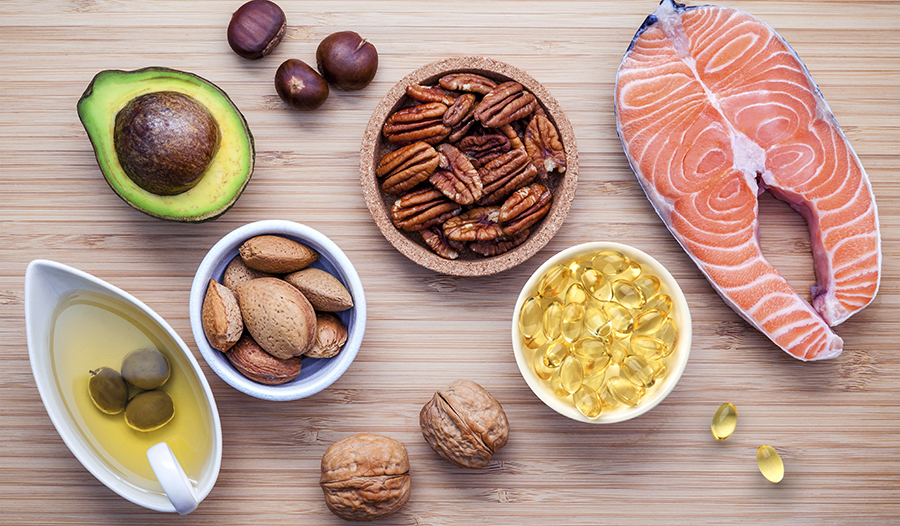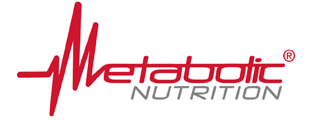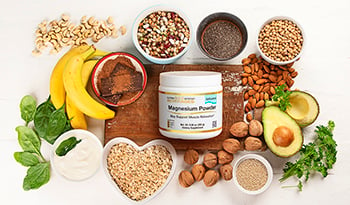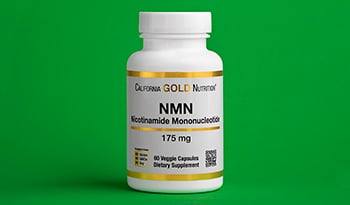The Different Forms and Benefits of Vitamin E

Are There Different Types of Vitamin E?
Tocopherols & Tocotrienols
There are eight different natural forms of vitamin E from a biochemical standpoint. Broadly, vitamin E can be subdivided into two separate groups: the tocopherols and the tocotrienols. Each of these has four separate forms: alpha, beta, delta, and gamma-tocopherol, and alpha, beta, delta, and gamma-tocotrienol.
Synthetic Vitamin E
Beyond the natural forms of vitamin E, synthetic versions also exist. When produced chemically, each type of vitamin E has eight possible structures due to what is called “stereoisomer centers.” These centers can be formed in two ways that are mirror images of each other. While the natural form has all three stereoisomer centers in the right-handed configuration, the synthetic version is an equal mix of all eight forms, including seven forms not typically found in natural versions of the vitamin.
RRR-alpha-tocopherol
The natural version of alpha-tocopherol is referred to as either RRR-alpha-tocopherol, all-rac-alpha-tocopherol, or historically as D-alpha tocopherol. The synthetic version is often called DL-alpha-tocopherol. The L indicates the presence of the left-handed, synthetic versions of the nutrient that have reduced vitamin E activity.
The Benefit of Vitamin E as an Antioxidant
As a nutrient, vitamin E, like vitamin C, plays a role in antioxidant defenses. Vitamin E is fat-soluble, meaning it readily dissolves and disperses in fats and lipids. In the body, vitamin E is the primary fat-soluble antioxidant that protects from free radical damage. Nutritional sources of vitamin E include oils, nuts, and seeds.
What is a Free Radical?
Free radicals are unstable molecules. They generally have an unpaired, reactive electron. Since electrons prefer to be in pairs, this lone electron will rip an electron from another molecule, damaging that molecule and often producing another free radical.
What is an Antioxidant?
Antioxidants help counter this damaging process. Antioxidants have spare electrons that they can safely transfer to free radicals, effectively quenching the process. In the body, a balance is needed between free radicals and antioxidants to keep things functioning normally.
Vitamin E’s Anti-inflammatory and Regulatory Effect
Free radicals are typically inflammatory. As such, antioxidants, in general, display anti-inflammatory activity. However, vitamin E has other anti-inflammatory activities beyond its antioxidant potential.
Different forms of the vitamin have been shown to more directly inhibit inflammatory pathways. Some forms of the vitamin also appear to help maintain healthy cells while encouraging cells that are damaged or diseased to die before they can reproduce and grow out of control.
Health Benefits of RRR-Alpha-Tocopherol
Inflammation
The main form of vitamin E found throughout the body is RRR-alpha-tocopherol. RRR-alpha-tocopherol, in a recent meta-analysis of clinical studies, was shown to have anti-inflammatory properties. Tumor necrosis factor-alpha (TNF-alpha) is a well-known inflammatory signaling molecule throughout the body. TNF-alpha is implicated in the disease process of numerous autoimmune inflammatory conditions. It is often targeted directly by standard medications to help decrease inflammation. In human trials, dosages greater than 700 mg/day of RRR-alpha-tocopherol reduced TNF-alpha significantly. Further research is needed to determine what clinical benefits may be possible for using the vitamin in decreasing TNF-alpha.
Heart Disease
While studies have been conducted on the benefits of RRR-alpha-tocopherol for heart disease, the latest research is quite mixed. Numerous studies with negative findings used the synthetic version of vitamin E, which clouds the results since synthetic vitamin E is chemically distinct from natural varieties.
Individuals who consume higher quantities of vitamin E from food have been shown to be at reduced risk for heart disease. The two largest natural vitamin E supplementation trials for heart disease prevention had opposing results, indicating the need for more clinical trials on natural RRR-alpha-tocopherol’s effects. Due to the mixed nature of the research, it’s hard to draw any conclusions on the impact of natural vitamin E and heart disease.
Fatty Liver Disease
Fatty liver disease is a condition correlated with obesity and diabetes. Metabolic changes, inflammation, and changes in gut flora cause a buildup of fat in the liver. Over time, the condition can progress to liver scarring and liver failure. The condition is often underdiagnosed and ignored until more severe liver problems manifest. Current estimates suggest a staggering number of people have the condition—approximately 25% of the world’s population. With increasing rates of diabetes and obesity, it is likely only going to get worse.
One of the most well-proven potential uses of natural alpha-tocopherol in the published research is for fatty liver disease. In fact, a recent review touted two “drugs” that they claimed were effective: pioglitazone (a standard drug) and vitamin E. Other reviews have come to similar conclusions, describing vitamin E as helping treat the inflammatory component of the condition in non-diabetics, although stressing that we still need more research.
Cognitive Decline and Dementia
The current evidence suggests some potential benefits with RRR-alpha-tocopherol for cognitive decline and dementia. However, it’s worth noting that vitamin E does not appear effective for prevention.
In patients who already have cognitive decline or early Alzheimer’s dementia, data suggests that vitamin E, as RRR-alpha-tocopherol, may slow the condition’s progression. While there is some variability in the research, on the whole, it does suggest some potential with the vitamin.
Health Benefits of RRR-Gamma-Tocopherol
Nitrogen Dioxide Free Radical Damage
Compared to alpha-tocopherol, there is a lot less research on RRR-gamma-tocopherol, although areas of interest are beginning to emerge. Evidence suggests that RRR-gamma-tocopherol is more effective in protecting from nitrogen dioxide-free radicals than RRR-alpha-tocopherol.
Damage from nitrogen dioxide, called nitrosative damage, can negatively affect DNA and inflammation, which could lead to chronic diseases such as heart disease and neurodegenerative (brain) disorders. Early studies suggest that RRR-gamma-tocopherol is better at preventing cell death and DNA damage from “nitrosative stress.”
Inflammation
Other evidence is beginning to show the direct effects of gamma-tocopherol on inflammatory pathways. An important enzyme involved with inflammation is cyclooxygenase (COX-1 and COX-2), the same enzymes targeted by aspirin and other non-steroidal anti-inflammatory drugs. At relevant concentrations, RRR-gamma-tocopherol inhibits COX-2 enzymes.
Asthma
Early evidence suggests that the unique properties of RRR-gamma-tocopherol may have a role in helping the respiratory system, especially with certain types of asthma. Obesity can increase risks for a form of asthma with excess neutrophils (white blood cells) irritating the airways in the lungs. This type of inflammation is often not responsive to corticosteroids used for asthma treatment. One research group has found that this type of inflammation in asthma is responsive to RRR-gamma-tocopherol and argues that it appears to be one of the first safe, cheap, and effective treatments.
RRR-Beta Tocopherol and RRR-Delta Tocopherol
While known to exist, little research has explored the function and clinical effects of both RRR-beta tocopherol and RRR-delta-tocopherol. They are both typically found in much lower quantities than alpha or gamma-tocopherol.
The Tocotrienols and Known Health Benefits
Similar to their tocopherol brethren, tocotrienols have four forms. When used as a supplement, they are frequently provided as a mix that includes all four. Not surprisingly, they also appear to have antioxidant and anti-inflammatory activity, although clinical studies are starting to unravel some potentially distinct advantages of the tocotrienols versus the tocopherols.
Still, it’s worth noting that our understanding of the tocotrienols and their physiological effects is in its infancy. More research is clearly needed to flesh out and understand their full range of effects.
Kidney Disease
Kidney disease is a difficult-to-treat condition that usually has a slow but steady progression to kidney failure. Standard approaches include treating high blood pressure and blood sugar issues in patients to help slow the progression. Approximately 40% of patients with diabetes eventually develop kidney failure. No standard treatment approaches have been shown to improve kidney function.
In patients with diabetic kidney disease, supplementation with mixed tocotrienols was shown to improve kidney function over the course of a year. While preliminary, these findings are exciting since few treatment approaches have been shown to improve kidney function.
Osteoporosis
The early stages of bone loss are called osteopenia. Women after menopause often have increased levels of bone loss. An early trial using tocotrienols in post-menopausal women with osteopenia was found to decrease bone loss and improve bone turnover. The authors hypothesized that tocotrienols improved bone loss through their antioxidant effects.
Brain Protective Effects
Animal studies have suggested that alpha-tocotrienol can protect brain cells. In rat and dog models of stroke, animals supplemented with alpha-tocotrienol showed enhanced brain cell protection and better outcomes.
A recent two-year study treated patients with brain white matter lesions—an early sign of brain degeneration—with mixed tocotrienols. While no significant difference was seen at one year, after two years of supplementation, the patients on placebo had worsening brain lesions, whereas the patients on tocotrienols remained unchanged. The results suggest that tocotrienols may slow or halt the progression of brain degeneration, a precursor to cognitive decline and dementia.
Cholesterol
Early clinical trials also suggest the benefits of tocotrienols on cholesterol levels. One small study found that a mix of palm tocotrienols decreased cholesterol by 10%. A separate study evaluated 100 mg of a tocotrienol-rich rice bran extract and found a 20% reduction in cholesterol with a 25% reduction in “bad” LDL cholesterol.
Fatty Liver Disease
Like RRR-alpha-tocopherol, tocotrienols appear to hold promise in protecting the liver. A clinical trial using tocotrienols for treating fatty liver disease found a halt in the disease process. In addition, at one year, more patients had a reversal of their fatty liver disease with tocotrienols compared to placebo. Other studies have also suggested benefits with tocotrienols on late-stage liver disease.
Safety
While some studies have made headlines by claiming significant risks from vitamin E, overall, vitamin E appears quite safe when used properly. The Institute of Medicine has set a maximum daily dose of 1000 mg for RRR-alpha-tocopherol. In high doses, vitamin E has blood-thinning effects, which can contribute to bleeding episodes, so it’s likely best to stay under the maximum dose.
It’s also interesting to note that supplementation of RRR-alpha-tocopherol alone depletes RRR-gamma-tocopherol. This could be part of the problem with high doses of only RRR-alpha-tocopherol without the other forms of natural vitamin E.
Takeaway
The natural forms of vitamin E appear to have some interesting potential benefits. Getting plenty of natural vitamin E from the diet, or supplementing with mixed tocopherol and tocotrienols, may have a place in helping with certain conditions. However, more research is still needed to draw firm conclusions and expand our understanding.
References:
- Cheng K, Niu Y, Zheng XC, et al. A Comparison of Natural (D-α-tocopherol) and Synthetic (DL-α-tocopherol Acetate) Vitamin E Supplementation on the Growth Performance, Meat Quality and Oxidative Status of Broilers. Asian-Australas J Anim Sci. 2016;29(5):681-688. doi:10.5713/ajas.15.0819
- Lobo V, Patil A, Phatak A, Chandra N. Free radicals, antioxidants and functional foods: Impact on human health. Pharmacogn Rev. 2010;4(8):118-126. doi:10.4103/0973-7847.70902
- Ungurianu A, Zanfirescu A, Nițulescu G, Margină D. Vitamin E beyond Its Antioxidant Label. Antioxidants (Basel). 2021;10(5):634. Published 2021 Apr 21. doi:10.3390/antiox10050634
- Asbaghi O, Sadeghian M, Nazarian B, et al. The effect of vitamin E supplementation on selected inflammatory biomarkers in adults: a systematic review and meta-analysis of randomized clinical trials. Sci Rep. 2020;10(1):17234. Published 2020 Oct 14. doi:10.1038/s41598-020-73741-6
- Knekt P, Reunanen A, Järvinen R, Seppänen R, Heliövaara M, Aromaa A. Antioxidant vitamin intake and coronary mortality in a longitudinal population study. Am J Epidemiol. 1994;139(12):1180-1189. doi:10.1093/oxfordjournals.aje.a116964
- Kushi LH, Folsom AR, Prineas RJ, Mink PJ, Wu Y, Bostick RM. Dietary antioxidant vitamins and death from coronary heart disease in postmenopausal women. N Engl J Med. 1996;334(18):1156-1162. doi:10.1056/NEJM199605023341803
- Rimm EB, Stampfer MJ, Ascherio A, Giovannucci E, Colditz GA, Willett WC. Vitamin E consumption and the risk of coronary heart disease in men. N Engl J Med. 1993;328(20):1450-1456. doi:10.1056/NEJM199305203282004
- Lee IM, Cook NR, Gaziano JM, et al. Vitamin E in the primary prevention of cardiovascular disease and cancer: the Women’s Health Study: a randomized controlled trial. JAMA. 2005;294(1):56-65. doi:10.1001/jama.294.1.56
- Heart Outcomes Prevention Evaluation Study Investigators, Yusuf S, Dagenais G, Pogue J, Bosch J, Sleight P. Vitamin E supplementation and cardiovascular events in high-risk patients. N Engl J Med. 2000;342(3):154-160. doi:10.1056/NEJM200001203420302
- Sesso HD, Buring JE, Christen WG, et al. Vitamins E and C in the prevention of cardiovascular disease in men: the Physicians’ Health Study II randomized controlled trial. JAMA. 2008;300(18):2123-2133. doi:10.1001/jama.2008.600
- Lonn E, Bosch J, Yusuf S, et al. Effects of long-term vitamin E supplementation on cardiovascular events and cancer: a randomized controlled trial. JAMA. 2005;293(11):1338-1347. doi:10.1001/jama.293.11.1338
- Saremi A, Arora R. Vitamin E and cardiovascular disease. Am J Ther. 2010;17(3):e56-e65. doi:10.1097/MJT.0b013e31819cdc9a
- Younossi ZM, Koenig AB, Abdelatif D, Fazel Y, Henry L, Wymer M. Global epidemiology of nonalcoholic fatty liver disease-Meta-analytic assessment of prevalence, incidence, and outcomes. Hepatology. 2016;64(1):73-84. doi:10.1002/hep.28431
- Martín-Mateos R, Albillos A. The Role of the Gut-Liver Axis in Metabolic Dysfunction-Associated Fatty Liver Disease. Front Immunol. 2021;12:660179. Published 2021 Apr 16. doi:10.3389/fimmu.2021.660179
- David D, Eapen CE. What Are the Current Pharmacological Therapies for Nonalcoholic Fatty Liver Disease? J Clin Exp Hepatol. 2021;11(2):232-238. doi:10.1016/j.jceh.2020.09.001
- Sharma M, Premkumar M, Kulkarni AV, Kumar P, Reddy DN, Rao NP. Drugs for Non-alcoholic Steatohepatitis (NASH): Quest for the Holy Grail. J Clin Transl Hepatol. 2021;9(1):40-50. doi:10.14218/JCTH.2020.00055
- Vlachos GS, Scarmeas N. Dietary interventions in mild cognitive impairment and dementia. Dialogues Clin Neurosci. 2019;21(1):69-82. doi:10.31887/DCNS.2019.21.1/nscarmeas
- Kang JH, Cook N, Manson J, Buring JE, Grodstein F. A randomized trial of vitamin E supplementation and cognitive function in women. Arch Intern Med. 2006;166(22):2462-2468. doi:10.1001/archinte.166.22.2462
- Dysken MW, Sano M, Asthana S, et al. Effect of vitamin E and memantine on functional decline in Alzheimer disease: the TEAM-AD VA cooperative randomized trial [published correction appears in JAMA. 2014 Mar 19;311(11):1161]. JAMA. 2014;311(1):33-44. doi:10.1001/jama.2013.282834
- Sano M, Ernesto C, Thomas RG, et al. A controlled trial of selegiline, alpha-tocopherol, or both as treatment for Alzheimer’s disease. The Alzheimer’s Disease Cooperative Study. N Engl J Med. 1997;336(17):1216-1222. doi:10.1056/NEJM199704243361704
- Thompson MD, Cooney RV. The Potential Physiological Role of γ-Tocopherol in Human Health: A Qualitative Review. Nutr Cancer. 2020;72(5):808-825. doi:10.1080/01635581.2019.1653472
- Jiang Q, Elson-Schwab I, Courtemanche C, Ames BN. gamma-tocopherol and its major metabolite, in contrast to alpha-tocopherol, inhibit cyclooxygenase activity in macrophages and epithelial cells. Proc Natl Acad Sci U S A. 2000;97(21):11494-11499. doi:10.1073/pnas.200357097
- Sood AK, Burbank AJ, Duran CG, et al. Gamma tocopherol effect on LPS-induced sputum neutrophilia is not modified by BMI or GSTM1 genotype. J Allergy Clin Immunol. 2019;143(5):1937-1939. doi:10.1016/j.jaci.2018.12.1009
- Vaidya SR, Aeddula NR. Chronic Renal Failure. In: StatPearls. Treasure Island (FL): StatPearls Publishing; December 1, 2020.
- Ng YT, Phang SCW, Tan GCJ, et al. The Effects of Tocotrienol-Rich Vitamin E (Tocovid) on Diabetic Neuropathy: A Phase II Randomized Controlled Trial. Nutrients. 2020;12(5):1522. Published 2020 May 23. doi:10.3390/nu12051522
- Shen CL, Yang S, Tomison MD, Romero AW, Felton CK, Mo H. Tocotrienol supplementation suppressed bone resorption and oxidative stress in postmenopausal osteopenic women: a 12-week randomized double-blinded placebo-controlled trial. Osteoporos Int. 2018;29(4):881-891. doi:10.1007/s00198-017-4356-x
- Gopalan Y, Shuaib IL, Magosso E, et al. Clinical investigation of the protective effects of palm vitamin E tocotrienols on brain white matter. Stroke. 2014;45(5):1422-1428. doi:10.1161/STROKEAHA.113.004449
- Khanna S, Roy S, Slivka A, et al. Neuroprotective properties of the natural vitamin E alpha-tocotrienol. Stroke. 2005;36(10):2258-2264. doi:10.1161/01.STR.0000181082.70763.22
- Rink C, Christoforidis G, Khanna S, et al. Tocotrienol vitamin E protects against preclinical canine ischemic stroke by inducing arteriogenesis. J Cereb Blood Flow Metab. 2011;31(11):2218-2230. doi:10.1038/jcbfm.2011.85
- Gopalan Y, Shuaib IL, Magosso E, et al. Clinical investigation of the protective effects of palm vitamin E tocotrienols on brain white matter. Stroke. 2014;45(5):1422-1428. doi:10.1161/STROKEAHA.113.004449
- Qureshi AA, Bradlow BA, Brace L, et al. Response of hypercholesterolemic subjects to administration of tocotrienols. Lipids. 1995;30(12):1171-1177. doi:10.1007/BF02536620
- Magosso E, Ansari MA, Gopalan Y, et al. Tocotrienols for normalisation of hepatic echogenic response in nonalcoholic fatty liver: a randomised placebo-controlled clinical trial. Nutr J. 2013;12(1):166. Published 2013 Dec 27. doi:10.1186/1475-2891-12-166
- Pervez MA, Khan DA, Ijaz A, Khan S. Effects of Delta-tocotrienol Supplementation on Liver Enzymes, Inflammation, Oxidative stress and Hepatic Steatosis in Patients with Nonalcoholic Fatty Liver Disease. Turk J Gastroenterol. 2018;29(2):170-176. doi:10.5152/tjg.2018.17297
- Catanzaro R, Zerbinati N, Solimene U, et al. Beneficial effect of refined red palm oil on lipid peroxidation and monocyte tissue factor in HCV-related liver disease: a randomized controlled study. Hepatobiliary Pancreat Dis Int. 2016;15(2):165-172. doi:10.1016/s1499-3872(16)60072-3
- Institute of Medicine (US) Panel on Dietary Antioxidants and Related Compounds. Dietary Reference Intakes for Vitamin C, Vitamin E, Selenium, and Carotenoids. Washington (DC): National Academies Press (US); 2000. Available from: https://www.ncbi.nlm.nih.gov/books/NBK225483/ doi: 10.17226/9810
DISCLAIMER:This Wellness Hub does not intend to provide diagnosis...
















































































 Table of Contents
Table of Contents
















